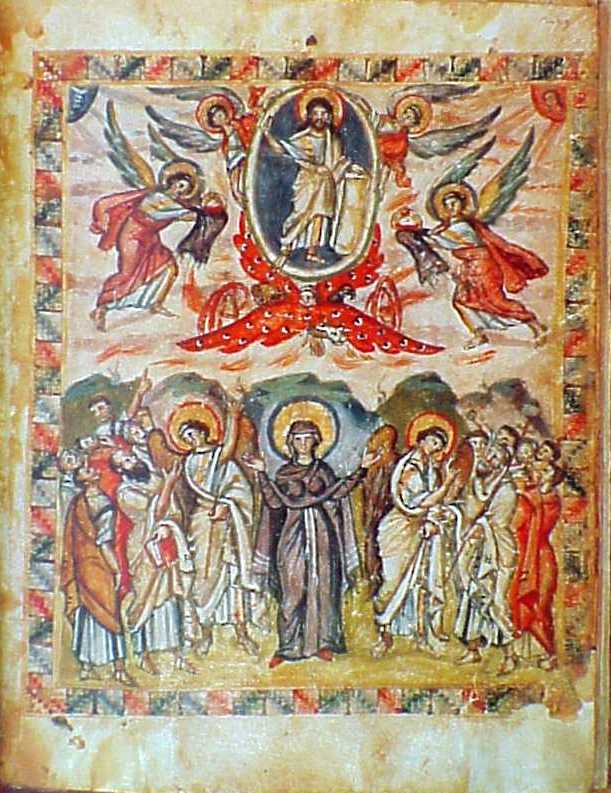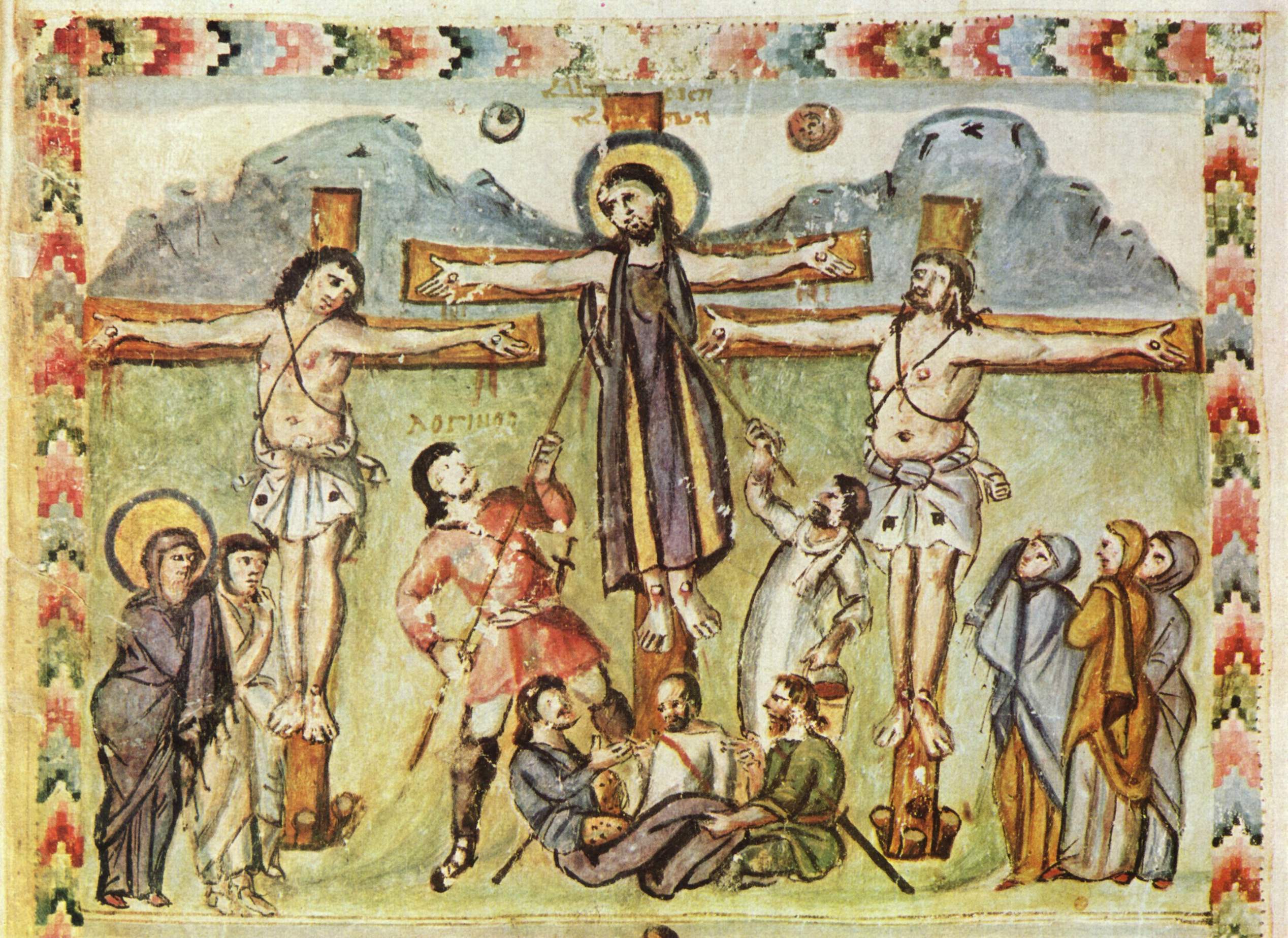Rabula Gospels on:
[Wikipedia]
[Google]
[Amazon]
 The Rabbula Gospels, or Rabula Gospels, (Florence, Biblioteca Medicea Laurenziana, cod. Plut. I, 56) is a 6th-century
The Rabbula Gospels, or Rabula Gospels, (Florence, Biblioteca Medicea Laurenziana, cod. Plut. I, 56) is a 6th-century
 The Gospel was completed in 586 at Monastery of St. John of Zagba (Syriac: , ), which, although traditionally thought to have been in Northern Mesopotamia, is now thought to have been in the hinterland between
The Gospel was completed in 586 at Monastery of St. John of Zagba (Syriac: , ), which, although traditionally thought to have been in Northern Mesopotamia, is now thought to have been in the hinterland between  The French Orientalist Edgard Blochet (1870–1937) argued that some of the folios of the manuscript, including the pictorial series, were an interpolation no earlier than the 10th or 11th century. Since the original Photo caption, caption accompanying the miniatures is of the same paleographic character as the main text of the manuscript, this theory was rejected by Giuseppe Furlani and by Carlo Cecchelli in the commentary of the facsimile edition of the miniatures published in 1959. But doubts as to the original unity of the contents continued. More recently, scholars have proposed that the text of 586 was only bound up together with the miniatures in the 15th century, and that the miniatures themselves were taken from at least one other original manuscript, and come from two different campaigns of work.Peers, Glenn
The French Orientalist Edgard Blochet (1870–1937) argued that some of the folios of the manuscript, including the pictorial series, were an interpolation no earlier than the 10th or 11th century. Since the original Photo caption, caption accompanying the miniatures is of the same paleographic character as the main text of the manuscript, this theory was rejected by Giuseppe Furlani and by Carlo Cecchelli in the commentary of the facsimile edition of the miniatures published in 1959. But doubts as to the original unity of the contents continued. More recently, scholars have proposed that the text of 586 was only bound up together with the miniatures in the 15th century, and that the miniatures themselves were taken from at least one other original manuscript, and come from two different campaigns of work.Peers, Glenn
Review of Bernabò
(see Further reading) The history of the manuscript after it was written is vague until the 11th century when it was at Byblos, Maipuc-Byblos, Lebanon. In the late 13th or early 14th century it came to Kadisha Valley#The Qannubin Monastery, Quannubin. In the late 15th or early 16th century, the manuscript was taken by the Maronite Patriarch to the Laurentian Library in Florence, where it is today. The manuscript has served during Medieval Age as register of Maronites Patriarches (Elias Kattar),
Election of the Apostle Mathias by the Eleven
*fol. 1
*fol. 2a Christ receives a book from two monks (dedication)
*fol. 3b-12b The Eusebian Canons, canon tables of Eusebius with smaller marginal miniatures *fol. 9
Matthew and John
*fol. 13a ''Crucifixion of Christ'' / ''Three Marys at the tomb'' *fol. 14a ''Ascension of Christ''
*fol. 14b ''Gift of the Holy Spirit at Pentecost''
Age of spirituality : late antique and early Christian art, third to seventh century
', no. 445, 1979, Metropolitan Museum of Art, New York, ; full text available online from The Metropolitan Museum of Art Libraries *. *.
The manuscript page-by-page online
{{Webarchive, url=https://web.archive.org/web/20160304190426/http://teca.bmlonline.it/ImageViewer/servlet/ImageViewer?idr=TECA0000025956&keyworks=Plut.01.56#page/1/mode/1up , date=2016-03-04
Blog with up-to-date bibliographyGrove Dictionary of Art (Rabbula Gospels)Homepage des Bistums Speyer (mit Kommentaren zu einzelnen Bildern)
Gospel Books Peshitta manuscripts Byzantine illuminated manuscripts 6th-century biblical manuscripts Maronite Church 6th-century illuminated manuscripts
 The Rabbula Gospels, or Rabula Gospels, (Florence, Biblioteca Medicea Laurenziana, cod. Plut. I, 56) is a 6th-century
The Rabbula Gospels, or Rabula Gospels, (Florence, Biblioteca Medicea Laurenziana, cod. Plut. I, 56) is a 6th-century illuminated
Illuminated may refer to:
* "Illuminated" (song), by Hurts
* Illuminated Film Company, a British animation house
* ''Illuminated'', alternative title of Black Sheep (Nat & Alex Wolff album)
* Illuminated manuscript
See also
* Illuminate (disambi ...
Syriac Syriac may refer to:
*Syriac language, an ancient dialect of Middle Aramaic
*Sureth, one of the modern dialects of Syriac spoken in the Nineveh Plains region
* Syriac alphabet
** Syriac (Unicode block)
** Syriac Supplement
* Neo-Aramaic languages a ...
Gospel Book
A Gospel Book, Evangelion, or Book of the Gospels (Greek: , ''Evangélion'') is a codex or bound volume containing one or more of the four Gospels of the Christian New Testament – normally all four – centering on the life of Jesus of Nazareth ...
. One of the finest Byzantine works produced in Asia
Asia (, ) is one of the world's most notable geographical regions, which is either considered a continent in its own right or a subcontinent of Eurasia, which shares the continental landmass of Afro-Eurasia with Africa. Asia covers an are ...
, and one of the earliest Christian manuscripts with large miniatures, it is distinguished by the miniaturist's predilection for bright colours, movement, drama, and expressionism. Coming from a period from in which little art survived, and which saw great development in Christian iconography, the manuscript has a significant place in art history, and is very often referred to.
Recent scholarship has suggested that the manuscript completed in 586 was later partly overpainted by restorers and bound together with miniatures from other sources in the 15th or 16th century.
Description
 The Gospel was completed in 586 at Monastery of St. John of Zagba (Syriac: , ), which, although traditionally thought to have been in Northern Mesopotamia, is now thought to have been in the hinterland between
The Gospel was completed in 586 at Monastery of St. John of Zagba (Syriac: , ), which, although traditionally thought to have been in Northern Mesopotamia, is now thought to have been in the hinterland between Antioch
Antioch on the Orontes (; grc-gre, Ἀντιόχεια ἡ ἐπὶ Ὀρόντου, ''Antiókheia hē epì Oróntou'', Learned ; also Syrian Antioch) grc-koi, Ἀντιόχεια ἡ ἐπὶ Ὀρόντου; or Ἀντιόχεια ἡ ἐπ� ...
and Apamea
Apamea or Apameia ( grc, Απάμεια) is the name of several Hellenistic cities in western Asia, after Apama, the Sogdian wife of Seleucus I Nicator, several of which are also former bishoprics and Catholic titular see.
Places called Apamea in ...
in modern Syria. It was signed by its scribe, Rabbula (, ) about whom nothing else is known. In their current condition the folios are 34 cm (13.4 in) by 27 cm (10.6 in). Their original size is unknown because they were trimmed during previous rebindings. The text is written in black or dark brown ink in two columns of a variable number of lines. There are footnotes written in red ink at the bottom of many of the columns. The text is the Peshitta version of the Syriac Syriac may refer to:
*Syriac language, an ancient dialect of Middle Aramaic
*Sureth, one of the modern dialects of Syriac spoken in the Nineveh Plains region
* Syriac alphabet
** Syriac (Unicode block)
** Syriac Supplement
* Neo-Aramaic languages a ...
translation of the Gospels.
The manuscript is illuminated, with the text framed in elaborate floral and architectural motifs. The Gospel canons are set in arcade (architecture), arcades ornamented with flowers and birds. The miniaturist obviously drew some of his inspiration from Hellenistic art (draped figures), but relied mainly on the ornamental traditions of Persia. The miniatures of the Rabbula Gospels, notably those representing the Crucifixion, the Ascension of Jesus Christ, Ascension and Pentecost, are real pictures with a decorative frame formed of zigzags, curves, rainbows and so forth. The scene of the Crucifixion is the earliest to survive in an illuminated manuscript, and shows the Eastern form of the image at the time. There is a miniature of the Apostles in the New Testament, Apostles choosing a new twelfth member (after the loss of Judas Iscariot, Judas); this is not an event found in the Canonical Gospels (though it is mentioned in Acts 1, Chapter 1 of Acts) and is almost never seen in later art. The artist was trained in the classical illusionist tradition, and is a competent and practiced hand rather than an outstanding talent; but surviving images from this period are so rare that his are extremely valuable for showing the style and iconography of his age.
 The French Orientalist Edgard Blochet (1870–1937) argued that some of the folios of the manuscript, including the pictorial series, were an interpolation no earlier than the 10th or 11th century. Since the original Photo caption, caption accompanying the miniatures is of the same paleographic character as the main text of the manuscript, this theory was rejected by Giuseppe Furlani and by Carlo Cecchelli in the commentary of the facsimile edition of the miniatures published in 1959. But doubts as to the original unity of the contents continued. More recently, scholars have proposed that the text of 586 was only bound up together with the miniatures in the 15th century, and that the miniatures themselves were taken from at least one other original manuscript, and come from two different campaigns of work.Peers, Glenn
The French Orientalist Edgard Blochet (1870–1937) argued that some of the folios of the manuscript, including the pictorial series, were an interpolation no earlier than the 10th or 11th century. Since the original Photo caption, caption accompanying the miniatures is of the same paleographic character as the main text of the manuscript, this theory was rejected by Giuseppe Furlani and by Carlo Cecchelli in the commentary of the facsimile edition of the miniatures published in 1959. But doubts as to the original unity of the contents continued. More recently, scholars have proposed that the text of 586 was only bound up together with the miniatures in the 15th century, and that the miniatures themselves were taken from at least one other original manuscript, and come from two different campaigns of work.Peers, GlennReview of Bernabò
(see Further reading) The history of the manuscript after it was written is vague until the 11th century when it was at Byblos, Maipuc-Byblos, Lebanon. In the late 13th or early 14th century it came to Kadisha Valley#The Qannubin Monastery, Quannubin. In the late 15th or early 16th century, the manuscript was taken by the Maronite Patriarch to the Laurentian Library in Florence, where it is today. The manuscript has served during Medieval Age as register of Maronites Patriarches (Elias Kattar),
Large miniatures
*fol. 1Election of the Apostle Mathias by the Eleven
*fol. 1
*fol. 2a Christ receives a book from two monks (dedication)
*fol. 3b-12b The Eusebian Canons, canon tables of Eusebius with smaller marginal miniatures *fol. 9
Matthew and John
*fol. 13a ''Crucifixion of Christ'' / ''Three Marys at the tomb'' *fol. 14a ''Ascension of Christ''
*fol. 14b ''Gift of the Holy Spirit at Pentecost''
See also
* Syriac versions of the Bible * Codex Phillipps 1388 * Garima Gospels * Nestorian Evangelion * Depiction of JesusReferences
Further reading
* Bernabò, Massimo, ed., ''Il Tetravangelo di Rabbula. Firenze, Biblioteca Medicea Laurenziana, plut. 1.56: L'illustrazione del Nuovo Testamento nella Siria del VI secolo'', Rome: Edizioni di Storia e Letteratura, 2008. * Kurt Weitzmann, Weitzmann, Kurt, ed.,Age of spirituality : late antique and early Christian art, third to seventh century
', no. 445, 1979, Metropolitan Museum of Art, New York, ; full text available online from The Metropolitan Museum of Art Libraries *. *.
External links
The manuscript page-by-page online
{{Webarchive, url=https://web.archive.org/web/20160304190426/http://teca.bmlonline.it/ImageViewer/servlet/ImageViewer?idr=TECA0000025956&keyworks=Plut.01.56#page/1/mode/1up , date=2016-03-04
Blog with up-to-date bibliography
Gospel Books Peshitta manuscripts Byzantine illuminated manuscripts 6th-century biblical manuscripts Maronite Church 6th-century illuminated manuscripts